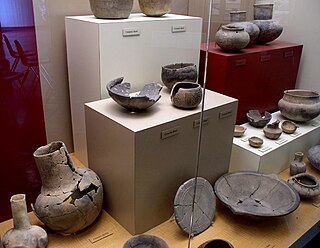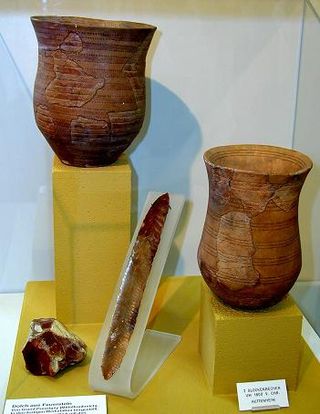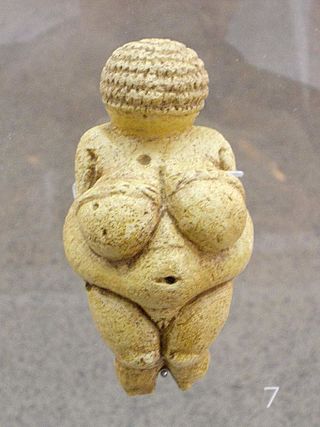Understanding past societies
Materialism and idealism
Whereas the processualists had been firm materialists, and the culture-historical archaeologists had, by contrast, been idealists, the post-processualists argued that past societies should be interpreted through both materialist and idealist ideas. As Johnson noted, "Many postprocessualists claim that we should reject the whole opposition between material and ideal in the first place." [6] While recognizing that past societies would have interpreted the world around them in a partially materialistic way, the post-processualists argue that many historic societies have also placed a great emphasis on ideology (which included religion) in both interpreting their world and influencing their behaviour. Examples of this can be seen in the work of Bernard Knapp, who examined how the social elite manipulated ideology to maintain their political and economic control, [14] and of Mike Parker Pearson, who asserted that tools were just as much a product of ideology as were a crown or a law code. [15]
Using an example to explain this belief in materialist-idealist unity, the archaeologist Matthew Johnson looked at the idea of landscape among past societies. He argued that:
- On the one hand, a materialist view of landscape tends to stress how it may be seen in terms of a set of resources, for example for hunter-gatherers or early farming groups. This leads one to turn, for example, to optimal foraging theory and other economic models for an understanding of how people exploited the landscape 'rationally'. Postprocessualists like to argue that landscapes are always viewed in different ways by different peoples. They reject the 'rational' view of 'landscape-as-a-set-of-resources' as that of our own society and one that is ideologically loaded in its own way, loaded towards ideas of commodity and exploitation found in our own society. They suggest that ancient peoples would have had different views of what was 'real' in that landscape. On the other hand, an exclusively idealist view of landscape does not work either. Postprocessualists like to stress that such an understanding of landscape was not formed in the abstract—that the way people moved around and used that landscape affected their understanding of it. [6]
Structuralism
Many, although not all post-processualists have adhered to the theory of structuralism in understanding historical societies. Structuralism itself was a theory developed by the French anthropologist Claude Lévi-Strauss (1908–2009), and held to the idea that "cultural patterns need not be caused by anything outside themselves… [and that] underlying every culture was a deep structure, or essence, governed by its own laws, that people were unaware of but which ensured regularities in the cultural productions that emanate from it." At the centre of his structuralist theory, Lévi-Strauss held that "all human thought was governed by conceptual dichotomies, or bilateral oppositions, such as culture/nature, male/female, day/night, and life/death. He believed that the principle of oppositions was a universal characteristic inherent in the human brain, but that each culture was based on a unique selection of oppositions". [16] This structuralist approach was first taken from anthropology and applied into forms of archaeology by the French archaeologist André Leroi-Gourhan (1911–1986), who used it to interpret prehistoric symbols in his 1964 work, Les Religions de la Préhistoire. [17]
Within the post-processual movement, Ian Hodder became "the leading exponent of a structuralist approach". [18] In a 1984 article, he looked at the similarities between the houses and the tombs of Neolithic Europe, and used a structuralist approach as a basis for his ideas on their symbolism. [19] He then went on, in his seminal book The Domestication of Europe (1990), to use structuralist ideas to come up with his theory that within Neolithic Europe, there was a dichotomy between field (agrios) and house (domus), with this duality being mediated by a boundary (foris). [20]
Human agency
Post-processualists have also adopted beliefs regarding human agency, arguing that in other theoretical approaches to archaeology such as cultural-historical and processual, "the individual is lost", and humans are therefore portrayed as "passive dupes who blindly follow social rules." [21] Post-processualists instead argue that humans are free agents who in many cases act in their own interests rather than simply following societal rules, and by accepting these ideas, post-processualists argue that society is conflict-driven. [22] Influenced by the sociologist Anthony Giddens (born 1938) and his structuration theory, many post-processualists accepted that most human beings, while knowing and understanding the rules of their society, choose to manipulate them rather than following them obediently. In turn, by bending the societal rules, these rules eventually change. [21]
Other post-processualists have instead taken the view of sociologist Karl Marx (1818–1883) that class conflict was the force for this social change. [23] In this manner they share similarities with Marxist archaeologists. A minority of post-processualists, such as Julian Thomas have however argued that human agency is not a useful aspect for looking at past societies, thereby accepting a culturally determinist position. [24]









